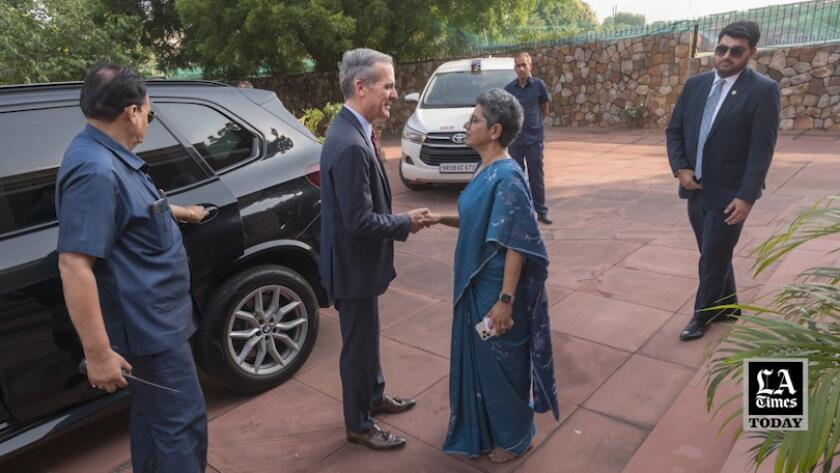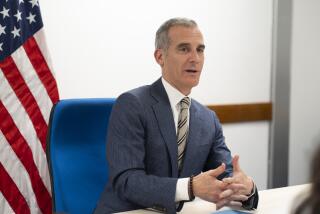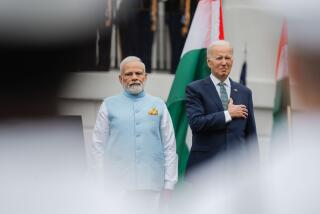Free from L.A., Eric Garcetti is reinventing himself in India

- Share via
NEW DELHI — Indian pop-fusion music blared from airport speakers as Eric Garcetti stood at the foot of Air Force One, waiting to greet his longtime ally and most important political patron, President Biden.
The former L.A. mayor, a bilingual Rhodes scholar and striving son of a famed district attorney, hadn’t planned to be here. As a key early endorser of Biden and the co-chair of his campaign, Garcetti had once seemed poised for a bright future in Washington, perhaps as a member of the new president’s Cabinet.
But as L.A.’s chief executive, Garcetti had struggled to make progress on some of the many problems that beset the pandemic-scarred city, including homelessness, crime and housing affordability. And as Biden assembled his team, former city employees claimed that Garcetti had known of allegations that one of his longtime aides was a serial sexual harasser — and had done nothing.
Garcetti denied knowing about the aide’s alleged misdeeds. But Biden ultimately nominated Garcetti as ambassador to India, not Transportation secretary or climate change advisor. His nomination languished in the Senate for 20 humiliating months before he finally won confirmation in March.
The job in New Delhi — where a right-wing, Hindu nationalist government has stoked anti-Muslim violence and challenged India’s secular and democratic identity — offered Garcetti a path to recovery, a chance to reset his narrative.
As ambassador, Garcetti negotiates with leaders of superpower nations and manages one of Washington’s most critical relationships. Biden administration officials say the rookie diplomat has handled his job masterfully.
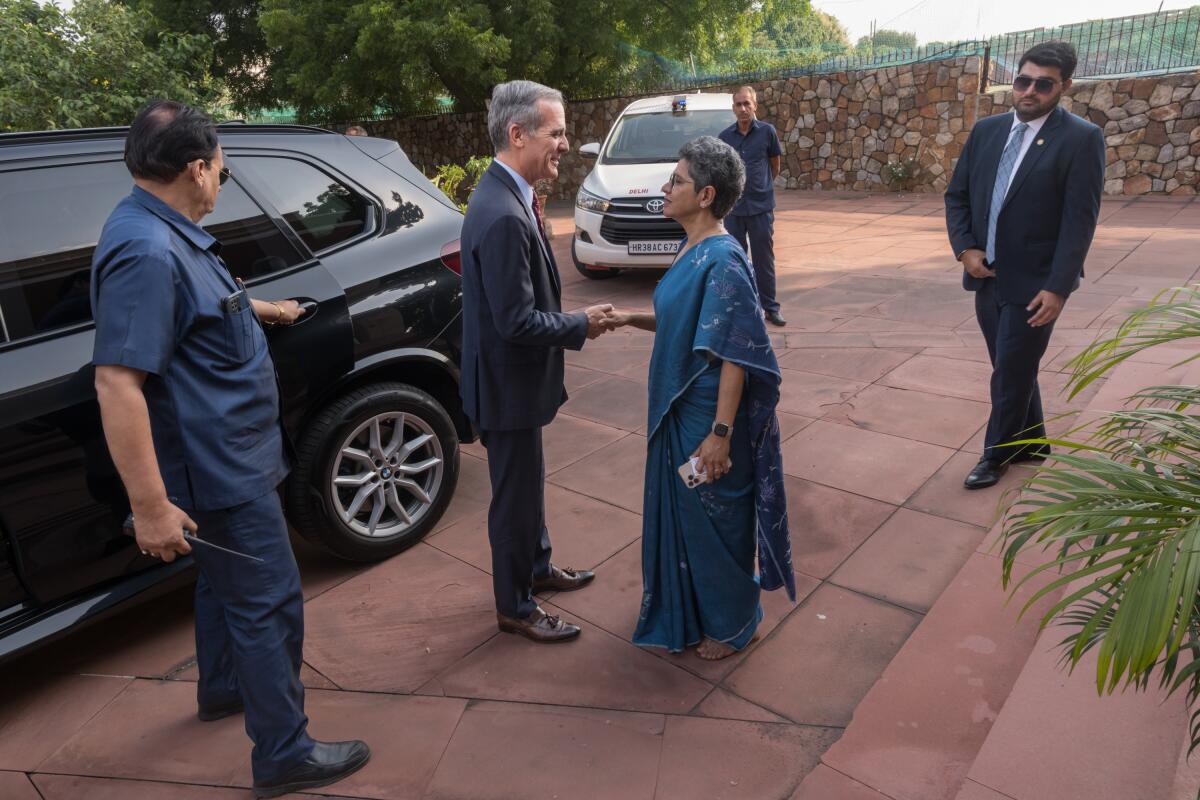
But it would be a mistake to assume that Garcetti, who was considered for Hillary Clinton’s running mate in 2016 and briefly flirted with a 2020 campaign for president, has given up his ambitions for higher office. The former mayor — by the way, just 52 — hardly considers his diplomatic reincarnation as the capstone of his career.
After all, it took Garcetti’s mentor and ally three tries and half a century to reach the office he had always sought. Speaking to The Times the day before Biden arrived for the Group of 20 summit, Garcetti had reflected on the lessons of Biden’s long fight to get him confirmed.
“He’s Joe Biden. He’s relentless,” he said. “It’s better to be lucky and loyal than, you know, conniving and calculating.”
Garcetti would no doubt love to have a Bidenesque career trajectory. But his path back to elected office is not yet clear.
“He’s very smart. He’s a great speaker … And he’s young, politically speaking. All the right kind of qualities to want to pursue a career beyond being ambassador to India,” said Jaime Regalado, professor emeritus of political science at Cal State Los Angeles. “He thinks he has a political row to hoe and I think he’s probably right. We just don’t know what it is or what kind of opportunity will really present itself.”
As Biden alighted from the plane in New Delhi, he waved to the crowd waiting under a blaze of floodlights. Garcetti smiled as the president pulled him in close for a handshake. Biden hugged the mayor’s 11-year-old daughter, Maya, who stood alongside her father for the Bollywood-style arrival.
As the president turned to watch dancers, draped in purple and black, perform on a stage in front of the terminal, Garcetti paused.
He leaned back and held up his phone to capture the moment.
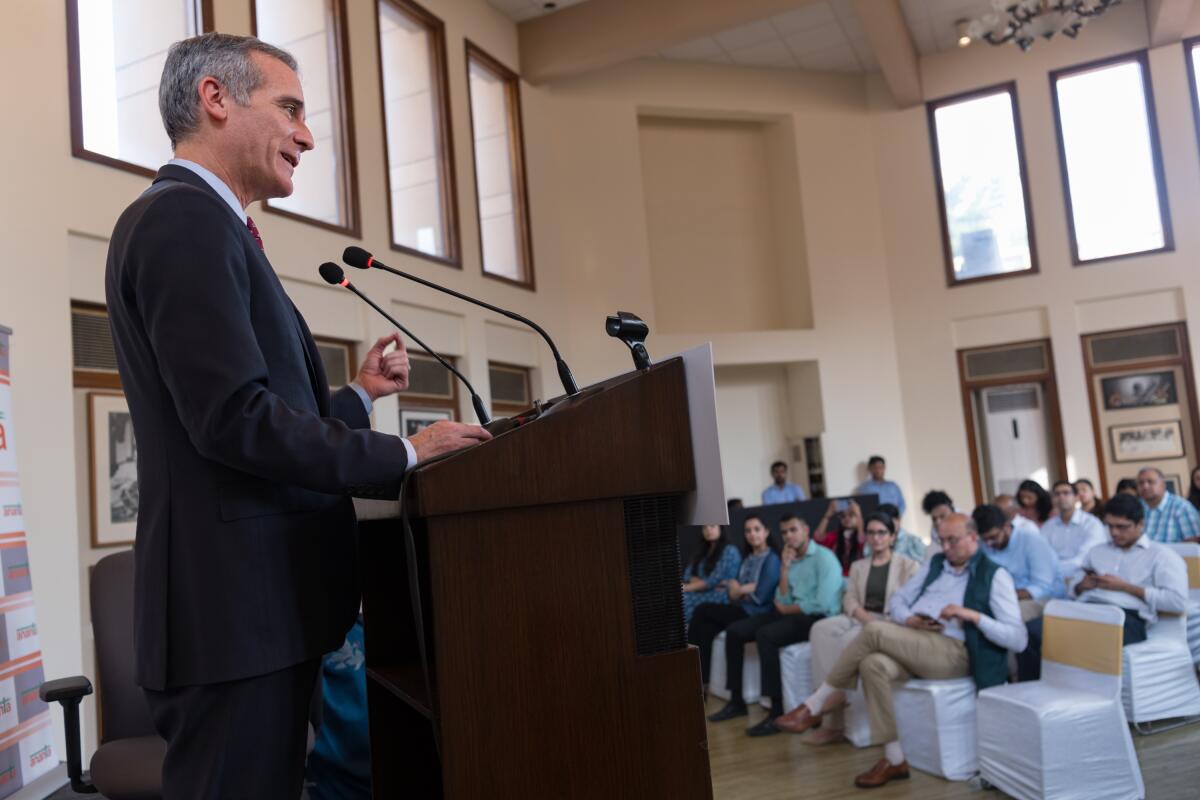
Garcetti grew up in a family that cared deeply about politics. His mother, Sukey Roth Garcetti, is the daughter of Harry Roth, an L.A. tailor whose company made expensive suits for the likes of Lyndon B. Johnson. In 1967, Roth took out a full-page ad in the New York Times urging his client, the president, not to run for reelection because of the Vietnam War.
For years, Garcetti’s mother ran the family foundation, which invested in L.A.-area organizations with the goal of promoting “progressive social change.”
The Garcettis traveled a lot. At age 14, Garcetti’s parents took him and his sister to India, where he was enthralled by a tea shop in the heart of Old Delhi, walls brimming with gold tins of withered leaves — saffron, Moroccan mint, white lavender and masala chai.
In 1990, at age 19, he returned to the country with his Columbia University roommate, whose father was serving as U.S. ambassador to India. Garcetti began studying Urdu and Hindi, diving into the Vedas and other classical Indian texts before applying in his junior year to a Buddhist studies program in Bodh Gaya, the holy pilgrimage site where Buddha was enlightened.
But Garcetti abandoned plans for the program after a student council victory, the first of a series of elections that vaulted him from the L.A. City Council to Getty House. (Garcetti’s father, Gil, was elected L.A. district attorney the year Eric graduated from college.)
When Biden phoned to offer Garcetti the ambassadorship in 2021, “It was like the hand of the universe reaching out, saying, ‘You’ve always wanted to be here. You always thought you would,’” he told The Times in a September interview at the palatial U.S. Embassy in Delhi’s diplomatic enclave of Chanakyapuri.
Biden was “kind of amazed and surprised” when Garcetti told him of his ties to India and the embassy there. “He had no idea,” Garcetti said.
Garcetti, who moved here immediately after his confirmation, misses L.A. sometimes, but he’s not pining for it. His wife, Amy Wakeland, arrived overnight in the middle of the G-20 — joining her husband and Maya, who moved to Delhi in August to begin the school year.
He has delighted in Delhi dinner parties, which can spill into the late hours as conversations veer from Greek philosophy and Gujurati textiles to the state of Indian cities and their storied histories. As he worked his way through Delhi’s streets and narrow alleyways, he revisited the tea shop that had captivated him as a boy — Aap ki pasand, the Hindi phrase for “as you like.”
“If Mumbai, like New York, is a city that just presents itself ... Delhi is more a city that reveals itself,” he said. “Both Delhi and L.A. just kind of happened. They weren’t really planned. I mean, it’s a very stimulating place to be.”
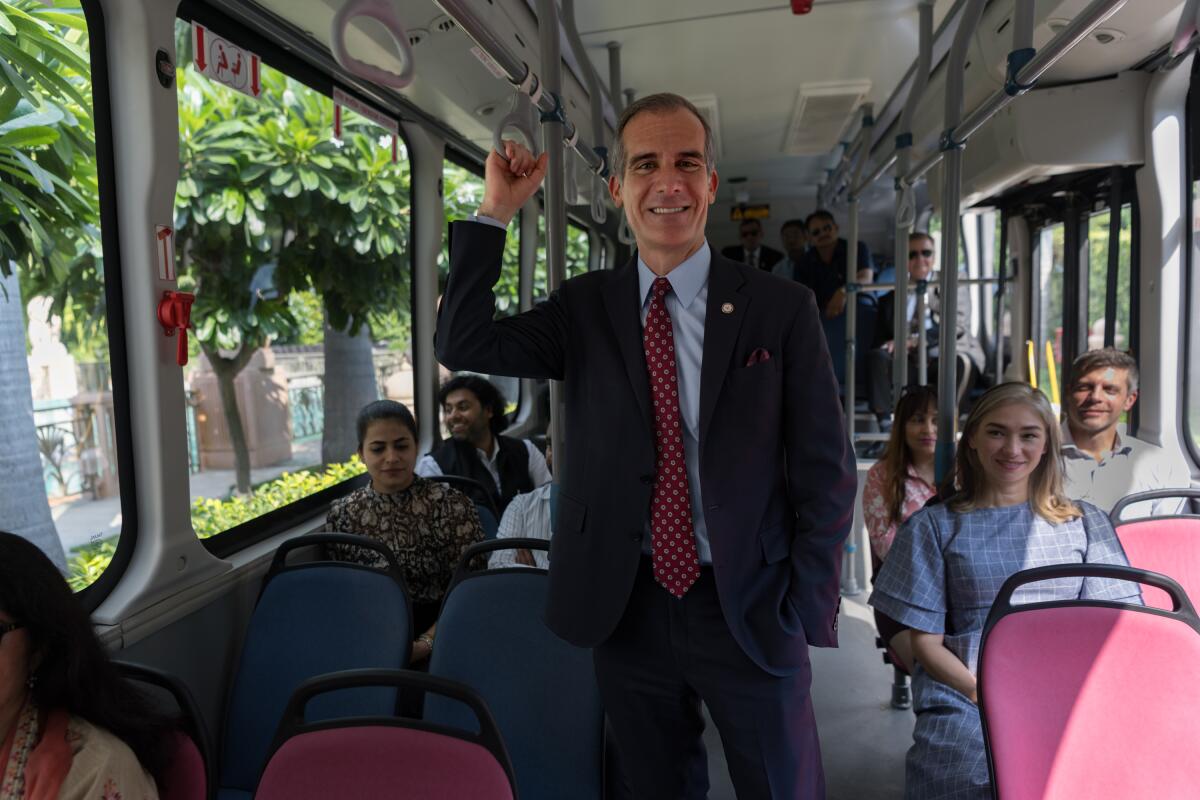
In the six months since he arrived in Delhi, he has visited 13 of India’s 36 states and union territories to meet with state and local officials and has appeared in dozens of interviews on Indian airwaves. He has helped ink a battery of deals, including one to allow General Electric to build jet engines in India and another to allow U.S. Navy ships to stop for repairs at Indian shipyards. He has welcomed a drumbeat of “VVIP’s,” or very very important persons, including the secretaries of State, Defense and Commerce and Treasury Secretary Janet Yellen, who has visited four times this year alone.
The job is “a lot of work but it’s great — good work,” Garcetti said. “You really feel like this is one of the centers of the universe right now.”
He’s not far off. Sharing a 2,000-mile border with China and located next to key maritime routes, India is a crucial part of Washington’s bulwark against a more assertive Beijing. Though India and the U.S. are not formal allies, Biden has sought to tighten the partnership, establishing high-level cooperation on defense and emerging technologies and working to resolve long-standing trade disputes at the World Trade Organization (though don’t expect a free trade agreement any time soon).
“The India-U.S. relationship will be our most important relationship that will define the drama and the possibilities for the 21st century,” said Kurt Campbell, the National Security Council coordinator for Indo-Pacific Affairs who is now Biden’s nominee for the No. 2 position at the State Department. “Ambassador Garcetti is exactly the person we want there at this time.”
But India, the world’s most populous country and fifth-largest economy, has also rankled Western leaders. New Delhi has refused to prioritize its relationship with the West over Russia, which it depends on for energy and weapons. Since the Russian invasion of Ukraine, India has continued to buy cheap oil from Russia and has resisted joining Western-led economic sanctions against Moscow.
And although Indian Prime Minister Narendra Modi’s June visit to the U.S. was a weeklong spectacle celebrating the two countries’ “shared values of freedom, democracy [and] human rights,” Modi’s Hindu nationalist government has allowed violence against Muslims to fester, passed a citizenship law that discriminates based on religion, revoked the special autonomous status granted to India’s only Muslim-majority territory, Jammu and Kashmir, and cracked down on press freedoms.
Religious and ethnic violence, spurred by Modi’s party and its policies, have exposed the fault lines in India’s diverse communities. The remote northeastern state of Manipur made international headlines in May when ethnic clashes prompted protests across the country and a statement from United Nations experts who said they were alarmed by serious human rights abuses and the government’s “inadequate” response. By August, the violence left more than 160 people dead and at least 60,000 others displaced.
Garcetti, who served on the board of the California chapter of the Human Rights Watch and maintained close ties to the progressive nonprofit Liberty Hill, told senators ahead of his confirmation that human rights would be a “core part” of his agenda as ambassador. But he has taken a more placating tone since arriving here, while insisting that he continues to quietly raise the issue without lecturing Indian counterparts about what they consider to be domestic issues.
“Democracies are complicated and diversity is difficult in our country and here. So those are legitimate concerns and ones we talk with Indians about all the time — both ways,” Garcetti said.
The ambassador’s message echoes White House sentiment on India. But it’s a far cry from what he told The Times a decade ago, when he was asked to reflect on a hunger strike he led at Oxford over the passage of a 1994 California ballot measure that denied immigrants access to state healthcare and schools. “In my book, whether it’s me in Los Angeles seeing an injustice across an ocean or vice versa, you have to stand up and be heard,” he said in a 2013 interview.
It was especially hard to ignore Modi’s heavy-handed approach during Biden’s visit to India. After Garcetti greeted him at the airport, the president held a bilateral meeting with the prime minister that was closed to reporters who traveled with him — a major departure from protocol.
Garcetti, who attended Biden’s meeting with Modi, said that he and other administration officials have pushed for press access in private conversations with Indian officials.
“I’ve been on the firing line. Trust me, it’s not always pleasant,” he said he has told his counterparts. “But I’d much rather live with a system in which you have the ability to have this conversation rather than in one in which we don’t or where there’s some censorship.”
The U.S.-India relationship was further strained in September by Canadian Prime Minister Justin Trudeau’s bombshell allegation linking the Indian government to the assassination of a Sikh separatist in British Columbia. The White House — caught between a long-standing ally and a strategic partner — has been quiet.
“Moments like this don’t define our relationship,” Garcetti told reporters.
Navigating diplomacy with one of the most important countries to Biden’s agenda has enabled Garcetti to flaunt his political deftness — and burnish his foreign policy credentials. The White House says it is happy with the results Garcetti has delivered, and considers the G-20 to have been a success, with the announcement of ambitious plans for a rail and shipping corridor connecting India and Europe through the Middle East.
But administration officials have no doubt about Garcetti’s most valuable quality.
“Politics is about many things, but sometimes an underappreciated element of being effective is loyalty, and he’s demonstrated that amply,” Campbell added.
The diplomatic corps is not the traditional springboard for higher office, of course. Many ambassadors who seek higher office lose. Though former Utah Gov. Jon Huntsman Jr. served as U.S. ambassador to Singapore before he won the governor’s mansion, he ultimately failed in his bid for the 2012 Republican presidential nomination after resigning as President Obama’s ambassador to China. He lost a second bid in Utah’s gubernatorial race in 2020 after serving as President Trump’s top diplomat in Russia.
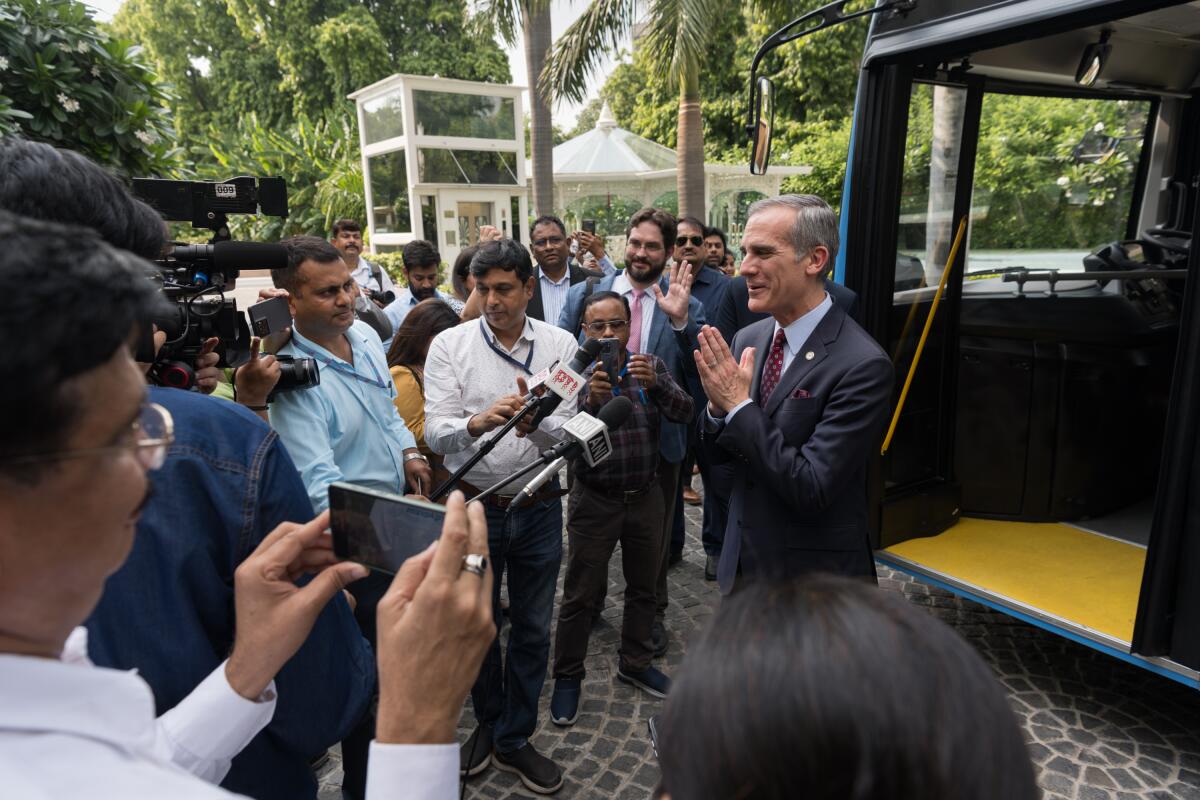
George H.W. Bush is the last former diplomat to serve as president. Bush convinced President Nixon to appoint him as U.S. ambassador to the U.N. and later served as President Ford’s chief of the U.S. Liaison Office in China, roles the future president saw as a way to polish his resume.
But for Garcetti, who ended his tenure as mayor on shaky footing, the path back to elected office may be murkier. In 2020, Black Lives Matter activists staged daily demonstrations outside the then-mayor’s home to protest his potential appointment to the Biden administration, slamming Garcetti’s record on homelessness, transportation and policing.
Regalado, the political scientist, said that Garcetti’s troubled exit could come back to haunt him, but his strengths may outweigh his political baggage.
“He’s still a relatively young political cat with more political lives to grow into,” Regalado said. “Whether you love him or dislike him or someplace in between, this is not the last we hear of Eric Garcetti.”
In New Delhi, Garcetti is looking ahead. He speaks about a strong U.S.-India relationship as a foregone conclusion, a “defining chapter” that he and the Biden administration are already etching into history.
When he returns to California, he will have foreign policy experience and a powerful ally in a president. He’s relentless. He’s loyal. Will he be lucky?
- Share via
Watch L.A. Times Today at 7 p.m. on Spectrum News 1 on Channel 1 or live stream on the Spectrum News App. Palos Verdes Peninsula and Orange County viewers can watch on Cox Systems on channel 99.
More to Read
Get the L.A. Times Politics newsletter
Deeply reported insights into legislation, politics and policy from Sacramento, Washington and beyond. In your inbox twice per week.
You may occasionally receive promotional content from the Los Angeles Times.
